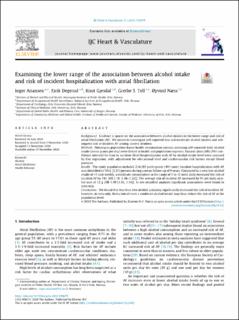| dc.contributor.author | Ariansen, Inger | |
| dc.contributor.author | Degerud, Eirik Magnus Meek | |
| dc.contributor.author | Gjesdal, Knut | |
| dc.contributor.author | Tell, Grethe S. | |
| dc.contributor.author | Næss, Øyvind | |
| dc.date.accessioned | 2021-01-20T14:14:24Z | |
| dc.date.available | 2021-01-20T14:14:24Z | |
| dc.date.created | 2021-01-05T12:47:12Z | |
| dc.date.issued | 2020 | |
| dc.identifier.issn | 2352-9067 | |
| dc.identifier.uri | https://hdl.handle.net/11250/2723975 | |
| dc.description.abstract | Background Evidence is sparse on the association between alcohol intakes in the lower range and risk of atrial fibrillation (AF). We aimed to investigate self-reported low and moderate alcohol intakes and subsequent risk of incident AF among current drinkers. Methods Norwegian population-based health examination surveys assessing self-reported daily alcohol intake (mean grams per day) were linked to health and population registers. Hazard ratios (HR) (95% confidence interval) for time to incident (first) hospitalization with AF by alcohol intake level were assessed by Cox regression, with adjustment for educational level and cardiovascular risk factors except blood pressure. Results The study population included 234,392 participants (49% men). Incident hospitalization with AF was identified in 5043 (2.2%) persons during a mean follow-up of 9 years. Compared to a very low alcohol intake of <1 unit weekly, a moderate consumption in the range of 1 to <2 units daily increased the risk of incident AF by 18% (HR 1.18 [1.06–1.32]). The average risk of incident AF increased by 9% per daily alcohol unit of 12 g (HR 1.09 [1.03, 1.14]). In sex-stratified analyses significant associations were found in men only. Conclusions We found that less than two alcohol units/day significantly increased the risk of incident AF, however, in men only. Reduction of even a moderate alcohol intake may thus reduce the risk of AF at the population level. | |
| dc.language.iso | eng | |
| dc.title | Examining the lower range of the association between alcohol intake and risk of incident hospitalization with atrial fibrillation | |
| dc.type | Peer reviewed | |
| dc.type | Journal article | |
| dc.description.version | publishedVersion | |
| dc.source.volume | 31 | |
| dc.source.journal | International journal of cardiology: Heart and Vasculature (IJCHA) | |
| dc.identifier.doi | 10.1016/j.ijcha.2020.100679 | |
| dc.identifier.cristin | 1865529 | |
| cristin.ispublished | true | |
| cristin.fulltext | original | |
| cristin.qualitycode | 1 | |
